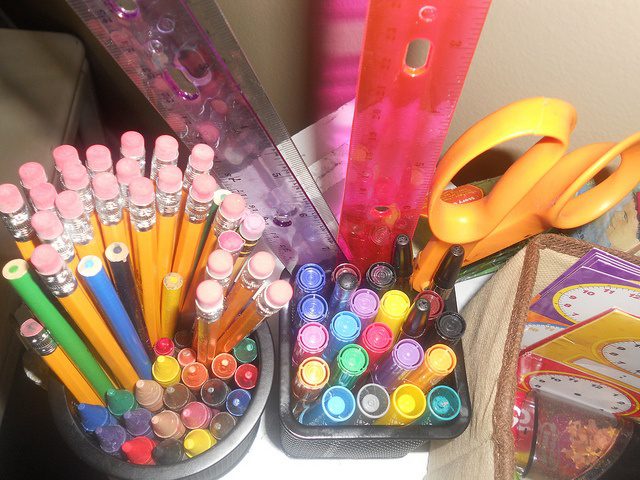
Ever wonder how all those school supplies make it into the extremely crowded “back to school” area of Walmart? The process involves a tightly connected network of buyers, suppliers, EDI providers, teachers and 29 million households. The “back to school” supply chain probably starts sometime in the spring, when buyers all over the US predict what will be most in demand for the coming school year. Will the pre-sharpened Ticonderoga pencils be available or not? Will pencil top erasers be on the supply lists? And will there be enough glue sticks for the two dozen each parent will be required to buy? As I walked around Walmart this year, frantically looking for everything on my twins’ supply lists, it occurred to me none of these people have any idea what led up to this chaos.
In the spring, buyers start looking at previous years’ sales on school supplies. Although many of these supplies are always carried in the stores, the levels needed for the “back to school” season will need to be drastically increased. This is largely how they decide on quantities. So if a store last year sold 5,000 cases of sharpened Ticonderoga pencils but only 1,000 unsharpened ones, maybe those quantities need to be adjusted to account for the difference and this year’s order quantities will reflect that. There’s also the matter of locale. In some regions, parents are NOT purchasing their children’s school supplies. In states with higher state income tax like California, parents rely on the schools to supply students with pencils and glue sticks, and those schools are likely buying those supplies via an online web portal, which is another blog topic. Although those parents are still shopping for folders and backpacks – it does not resemble Christmas Eve at noon like your average Arizona Staples in August.
Once those buyers are ready to place their orders, they notify their suppliers of their vendor expectations and that usually involves Electronic Data Interchange (EDI). Unless the supplier is a huge company like Elmer’s Glue, who probably has been EDI capable for 20 years, the supplier will need to implement an EDI solution in order to accept EDI 850s (POs) and send back EDI 810s (invoices). The small company that makes plastic pencil cases and lands a deal with Target will likely need to research and choose an EDI provider. Once the EDI relationship with Target is established, they will need to get through testing in time to ship those POs by the deadline. Then the supplier hopes that my children will want those cases (along with thousands of others) and they will get repeat orders.
Once the shelves are stocked, parents are logging into the district website to download the supply lists that were requested by the teachers. My list his year called for headphones, two boxes of 24 count crayons, erasers, a red spiral notebook, washable markers, 2-pocket folders and the list goes on. Considering I spent close to $100 for both of my children, this is big business. According to the National Retail Federation, 2017 back to school spending will reach $83.6 billion. It is the second busiest shopping season of the year and encompasses more than just pencils. Also on my supply lists were antibacterial wipes, Ziploc bags, hand sanitizer and Kleenex. The stores’ merchandising departments have figured this out because ALL of these items were available in the “back to school” area of the store. Many parents are also purchasing higher dollar items like school uniforms, laptops and other gadgets.
One segment of this industry that is steadily growing in popularity is the category of prepackaged kits that are available from online retailers like www.edukitinc.com. Edukit works in cooperation with schools to assemble boxes of supplies each grade level has requested, including specific brands as well as quantities and offers these boxes for one price, delivered directly to the school. The limitation is your school must participate in the program and as of this writing, my school did not. According to Deloitte, parents will spend on average 40% more on these pre-assembled boxes, but this just goes to show that convenience offers value to busy parents, and they are willing to pony up. Other companies that offer these kits include www.schoolkidz.com (owned by Staples) and www.schooltoolbox.com.
As you are shopping this weekend for YOUR kids and trying to navigate the sea of people with their lists, just imagine all that has gone into this busy shopping season, how many hours are put in by all involved from the buyer to the merchandiser, and how much money is being poured into the economy. Not to mention how much teachers are spending out of their own paychecks to educate our children. I guarantee that $100 will not seem so bad.
Learn more about how to thrive in a world full of supply chain challenges in our free eBook: Supply Chain Insights








